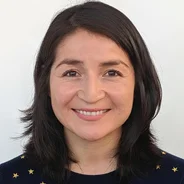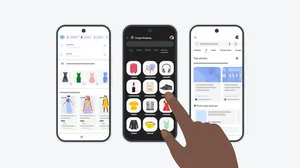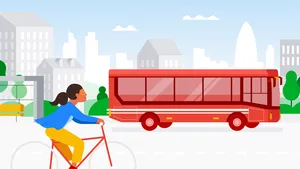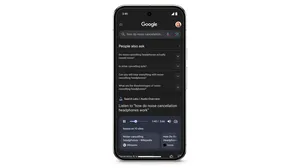7 ways to celebrate Native American Heritage Month with Google
My great-grandfather was Chief Sam George of the Nooksack Indian tribe. During his time as Chief, he championed our tribe by speaking to governmental bodies like the United States Congress and what is now known as the Bureau of Indian Affairs to secure healthcare, housing and education for his people. He focused on the most fundamental and pressing issues of his time, using the tools he had, knowing that improvement on those fronts would benefit future generations.
Through my work at Google and as one of the global leads of the Google Aboriginal and Indigenous Network (GAIN) employee resource group, I’m also in a position to help my community, using Google’s technology to bring their businesses online, connect them with resources to build digital skills and more.
As November unfolds, we embark on a month-long celebration of Native American heritage, and Google is honoring Indigenous cultures through our products and services. Here’s how we’re honoring and amplifying Indigenous voices throughout the month.
1. Highlighting Indigenous businesses
Starting today, it will now be easier to find Indigenous-owned businesses in your community. Merchants in the U.S. with a verified Business Profile can add an Indigenous-owned attribute to their profile, making it easier for customers to find and support them through Search and Maps. Throughout the process of creating this attribute, we worked in partnership with the National Congress of American Indians and members of GAIN. This new offering joins the available Asian-owned, Black-owned, disabled-owned, Latino-owned, LGBTQ+ owned, veteran-owned and women-owned business attributes.
Eighth Generation displays the Indigenous-owned attribute
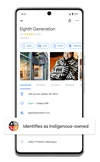
As part of this launch, we created a video to tell the story of another Nooksack member, Louie Gong, who founded the lifestyle brand Eighth Generation in part to create more opportunities for Indigenous artists. Today, Eighth Generation is owned by the Snoqualmie Tribe and partners with community-based Indigenous artists around the country to design, manufacture and market wool blankets and gifts intended for everyone around the world. During our filming, I was struck by what Louie shared about the importance of supporting Indigenous-owned businesses: "The more true we can be about our identity, the more consumers can make values based decisions to support Native-owned businesses, and thereby strengthen the actual stewards of the cultural art, and the cultural stories that they want to align with."
Our hope is that this attribute will help enable support for Indigenous-owned businesses like Eighth Generation by providing another way for consumers to support a diversity of businesses across Google’s products and platforms.
2. Offering digital skills training and broadening access to computer science education
Grow with Google and the National Congress of American Indians (NCAI) are partnering to offer digital skills training led by Grow with Google Indigenous Community Digital Coach, Jake Foreman. Jake hosts free digital skills workshops, hands-on coaching and opportunities for Indigenous businesses to learn from one another year-round as part of the Digital Coaches program. Jake will deliver in-person workshops at the NCAI 80th Annual Convention to help Indigenous entrepreneurs grow their businesses with digital tools, including the Indigenous-owned attribute.
Jake as he trains someone during a 1:1 session

This work builds on Grow with Google’s efforts to broaden access to education. This year, we committed $600,000 in grants to bring culturally responsive computer science education to over 10,000 students with Indigitize, and community-building professional development to over 400 Indigenous-serving educators in partnership with the CS Alliance, AISES and CSTA.
3. Amplifying Native art and the artists behind them
Chrome and Chrome OS’s Native American Artists Series features custom wallpapers and browser themes that reflect the unique perspectives and experiences of each commissioned artist. Visit the Chrome Web Store or your Chromebook’s wallpaper gallery to apply them or you can also open a new tab in Chrome and click the “Customize Chrome” button on the bottom right to explore all of our Artist Series collections. Look out for our newest four themes by Lynne Hardy, added just last month.
A sample of the collection of custom wallpapers available in the Native American Artists series.

4. Growing our digital collection of Indigenous art and experiences
We’re expanding Google Arts & Culture’s Indigenous Americas hub, which honors Native groups’ rich heritage and evolving presence, with the addition of nine new exhibits. Check out stories like Indigenous design from the Arctic with Alaska’s Anchorage Museum (starting with snow goggles and the kayak), and a survey of Indigenous female musicians from the Kennedy Center for the Performing Arts, or join experiences like a Web Pocket Gallery curated by NotoriousCree.
The updated hub spotlights Native-led partners, including the Smithsonian National Museum of the American Indian, the Lenape Center and Honoring Nations at Harvard University, among more than 50 other collaborating partners, to offer a substantial and educational resource for anyone who wants to learn more.
Artists have ways of shedding light onto histories and truths that leave lasting impressions. From forced relocation to the generational traumas of residential schools to internal strength and self-awareness, Indigenous contemporary artists add to our understanding of such histories, truths, and lived experiences.
Samantha Crain (Choctaw), pictured, is a two-time winner of the Native American Music Award and best known for music that defies categorization, merging folk music with country rock and college indie. Learn more about contemporary Indigenous women singer-songwriters’ who are shaking up the music landscape in a new story by the Kennedy Center.
So many Indigenous technologies have informed, inspired, or anticipated modern-day design and technology innovations – like the kayak, snow goggles, fur parka, and so much more. Read Part 1 and 2 of a new series by Alaska's Anchorage Museum.
New York's only remaining Lenape group is sharing a photographic story about the return home of ancestral seeds to Lenapehoking. This series by Devin Pickering was taken over a period of five months, was also mounted at the Perelman Performing Arts Center.
5. Amplifying Indigenous authors through curated collections
Google Play will be featuring Native and Indigenous authors throughout the Store. You can browse a collection of books curated by Blackfeet Native American author Stephen Graham-Jones, as well as more collections of e-books, audiobooks, and children's books highlighting Native and Indigenous authors.
The Stephen Graham-Jones collection in the Google Play Store
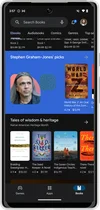
6. Supporting robotics and AI education for Indigenous students
As a part of Google.org’s $10 million commitment to help middle-school students across the U.S. access robotics and AI education, we’re providing a $500,000 grant to the REC Foundation to support robotics education for Indigenous students living on U.S. Tribal Reservations. Over 60 tribal educators across 14 states will receive training and supplies to incorporate coding, digital skills and AI education into their STEM curriculum, with the goal of supporting 7,500+ Indigenous students to grow their skills and prepare for the jobs of tomorrow.
7. Celebrating a cultural icon and legend
On November 3, we'll celebrate Allan Haozous (Houser), who was a Chiricahua Apache sculptor, painter and book illustrator born in Oklahoma, with a Google Doodle on the Search homepage. Houser was one of the most renowned Native American painters and Modernist sculptors of the 20th century. The Doodle was created by New Mexico-based, Chiricahua Apache guest artist Lynnette Haozous.
The Google Doodle of Allan Haozous (Houser)

